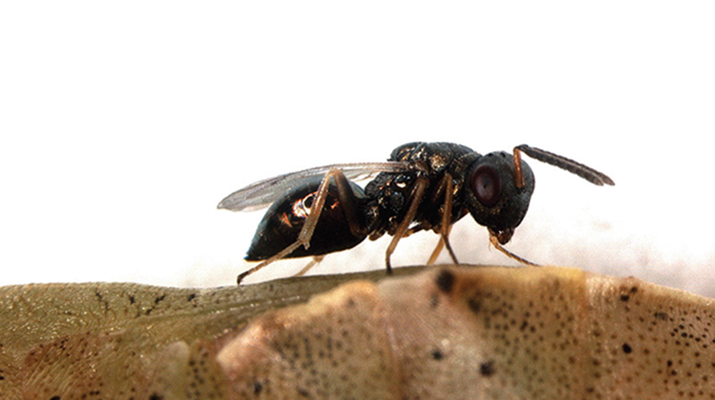JBC: Serpins in wasp venom block host immune response
In May 1860, a bewildered Charles Darwin wrote a letter to the botanist Asa Gray to say, “I cannot persuade myself that a beneficent and omnipotent God would have designedly created the Ichneumonidae with the express intention of their feeding within the living bodies of caterpillars.”
Darwin was referring to parasitoid wasps. This group of insects is estimated to have up to 600,000 species, according to at the Institute of Insect Science in Zhejiang University in China. The number makes parasitoid wasps the most abundant and diverse group of insects on Earth. The study of some of the molecular mechanisms of the relationship between one of these parasitoid wasps and its host, a butterfly, is the subject of Ye’s in the . Ye and colleagues described the discovery of a splicing isoform of a serine protease inhibitor found in the venom of the wasp that can inhibit its host’s immunity.
Endoparasitoid wasps lay their eggs inside the body of their hosts, while ectoparasitoid wasps do so on the body surface of their hosts. Eggs hatch and feed on the hosts, killing them.

Most of the known pest insects that attack crops are preyed upon by parasitoid wasps, which is why they regularly have been deployed to protect crops. Pteromalus puparum is a gregarious endoparasitoid wasp that attacks the pupal stage of several butterfly species, including Pieris rapae, the cabbage white butterfly, which can be a problem in commercial farming of cabbage, broccoli and cauliflower.
Ye explains that to increase the chance of survival of its offspring, these wasps inject venom along with their eggs to suppress host immune defenses. Melanization, one of the processes of host immunity, is a conserved and highly regulated process. It consists of a series of serine protease activation reactions that culminate in the production of prophenoloxidase-activating proteases, which further catalyze the conversion of prophenoloxidase into phenoloxidase. In turn, phenoloxidase oxidizes tyrosine and o-diphenols to quinones, which polymerize to form melanin that can cover the surface of pest invaders and keep them from spreading or hatching and completing development.
In a previous study, using a combination of transcriptomic and proteomic approaches, Ye and colleagues found that the venom of P. puparum contains at least 70 different putative proteins that include proteases, inhibitors, and recognition and binding proteins.
In the JBC paper, Ye and colleagues show that the P. puparum venom blocks melanization by both the host pupae and larvae. By using a number of protein fractionation steps followed by sequence analyses of the isolated proteins, the authors identified a serine protease inhibitor or serpin. They named this inhibitor PpS1V.
Serpins are a family of inhibitors that react with their target protease via a reactive center loop to form an inactive complex. Ye and colleagues found that PpS1V is one of the 16 predicted putative splicing isoforms that differ in their eighth and last exon, which contains the reactive center loop. They found that PpS1V binds and inhibits the activity of a previously unknown host protein, which they called P. rapae prophenoloxidase-activating proteinase 1, which is possibly involved in melanization by the host.
Ye thinks that uncovering the mechanisms by which parasitoid wasps inhibit host immunity will yield potential candidates for novel insecticides. Considering the parasitoid wasps’ diversity, these animals are an untapped source of bioactive compounds for pest control and drug discovery.
Enjoy reading 91—«…´¥´√Ω Today?
Become a member to receive the print edition four times a year and the digital edition monthly.
Learn moreGet the latest from 91—«…´¥´√Ω Today
Enter your email address, and we’ll send you a weekly email with recent articles, interviews and more.
Latest in Science
Science highlights or most popular articles

Unraveling oncogenesis: What makes cancer tick?
Learn about the 91—«…´¥´√Ω 2025 symposium on oncogenic hubs: chromatin regulatory and transcriptional complexes in cancer.

Exploring lipid metabolism: A journey through time and innovation
Recent lipid metabolism research has unveiled critical insights into lipid‚Äìprotein interactions, offering potential therapeutic targets for metabolic and neurodegenerative diseases. Check out the latest in lipid science at the 91—«…´¥´√Ω annual meeting.

Melissa Moore to speak at 91—«…´¥´√Ω 2025
Richard Silverman and Melissa Moore are the featured speakers at the 91—«…´¥´√Ω annual meeting to be held April 12-15 in Chicago.

A new kind of stem cell is revolutionizing regenerative medicine
Induced pluripotent stem cells are paving the way for personalized treatments to diabetes, vision loss and more. However, scientists still face hurdles such as strict regulations, scalability, cell longevity and immune rejection.

Engineering the future with synthetic biology
Learn about the 91—«…´¥´√Ω 2025 symposium on synthetic biology, featuring applications to better human and environmental health.

Scientists find bacterial ‘Achilles’ heel’ to combat antibiotic resistance
Alejandro Vila, an 91—«…´¥´√Ω Breakthroughs speaker, discussed his work on metallo-Œ≤-lactamase enzymes and their dependence on zinc.

